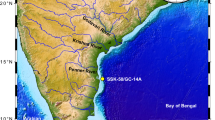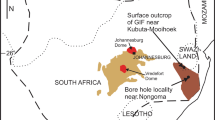Abstract
MAGNETOFOSSILS1, the fossil remains of bacterial magneto-somes2, are found in various deep-sea sediments, and have been linked to the preservation of stable natural remanent magnetization in many of them1,3–5. They have also been extracted and identified from lithified carbonates of Jurassic5 and Precambrian6 age, showing that magnetotactic bacteria have been a sedimentary source of fine-grained magnetite for much of geological time. Some clay-rich deep-sea sediments, however, do not record a stable remanent magnetization, for unknown reasons. Here we report results from a high-resolution transmission-electron-microscope study on samples of this type collected by the Deep Sea Drilling Project (DSDP); the material contains a complex mixture of single-domain magnetic minerals. Well-preserved magnetofossils show the same crystal structures as those found in magnetosomes from recent bacteria7–10, whereas others in these same preparations display a wide range of dissolution, corrosion and aggregation effects. Rock magnetic measurements are consistent with the presence of these alterations in many DSDP sediments, including those that preserve reliable palaeomagnetic directions. As we were unable to fina authigenic magnetic minerals in our sample, and as the magnetic fraction is dominated by well preserved magnetofossils, we suggest that the poor preservation of the magnetization is a result of diagenetic interactions between the magnetofossils and the clay minerals in the matrix.
This is a preview of subscription content, access via your institution
Access options
Subscribe to this journal
Receive 51 print issues and online access
$199.00 per year
only $3.90 per issue
Buy this article
- Purchase on Springer Link
- Instant access to full article PDF
Prices may be subject to local taxes which are calculated during checkout
Similar content being viewed by others
References
Kirschvink, J. L. & Chang, S.-B. R. Geology 12, 559–562 (1984).
Blakemore, R. P. A. Rev. Microbiol. 36, 217–238 (1982).
Petersen, N., von Dobeneck, T. & Vali, H. Nature 320, 611–615 (1986).
Stolz, J. F., Chang, S.-B. R. & Kirschvink, J. L., Nature 321, 849–851 (1986).
Vali, H., Förster, O., Amarantidis, G., & Petersen, N. Earth planet. Sci. Lett. 86, 389–400 (1987).
Chang, S.-B. R. & Kirschvink, J. L. A. Rev. Earth planet. Sci. 17, 169–195 (1989).
Matsuda, T., Endo, J., Osakabe, N. & Arii, T. Nature 302, 411–412 (1983).
Mann, S., Frankel, R. B. & Blakemore, R. P. Nature 310, 405–407 (1984).
Mann, S., Sparks, N. H. C. & Blakemore, R. P. Proc. R. Soc. Lond. B 231, 469–476 (1987).
Mann, S., Sparks, N. H. C. & Blakemore, R. P. Proc. R. Soc. Lond. B 231, 477–487 (1987).
Tauxe, L., Tucker, P., Petersen, N. P. & LaBrecque, J. L. Init. Rep. Deep Sea Drilling Project LXIII 609–621 (1984).
Vali, H. et al. Geol. Rdsch. (submitted).
Schwertmann, U. & Taylor, R. M. in Minerals in Soil Environments 145–180 (Soil Science Society of America, Inc., Madison, 1977).
Maher, B. A. & Taylor, R. M. Nature 336, 368–370 (1988).
Banerjee, S. K. Nature 336, 314 (1988).
von Dobeneck, T., Petersen, N. & Vali, H. Geowissenschaften in unserer Zeit 5, 27–35 (1987).
Butler, R. F. & Banerjee, S. K. J. geophys. Res. 80, 4049–4058 (1975).
Smith, P. P. K. Can. J. Earth Sci. 16, 375–379 (1979).
Morgan, G. E. & Smith, P. P. K. Earth planet. Sci. Lett. 53, 226–240 (1981).
Taylor, R. M., Maher, B. A. & Self, P. G. Clay Minerals 22, 411–422 (1987).
Karlin, R., Lyle, M. & Heath, G. R. Nature 326, 490–493 (1987).
Elmore, R. D. et al. Nature 325, 428–430 (1987).
McCabe, C., Van der Voo, R., Oeacor, D. R., Scotese, C. R. & Freeman, R. Geology 11, 221–223 (1983).
LovJie, D. R., Stolz, J. F., Nord, G. L. Jr & Phillips, E. J. P. Nature 330, 252–254 (1987).
Paoletti, L. C. & Blakemore, R. P. J. Bacteriology 167, 73–76 (1986).
Vali, H. & Bachmann, L. J. Colloid Interface Sci. 126, 278–291 (1988).
Moskowitz, B. M., Frankel, R. B., Flanders, P. J., Blakemore, R. P. & Schwartz, B. B. J. Magn. mag. Mater. 73, 273–288 (1988).
Cisowski, S., Phys. Earth Planet. Inter. 26, 56–62 (1981).
Author information
Authors and Affiliations
Rights and permissions
About this article
Cite this article
Vali, H., Kirschvink, J. Magnetofossil dissolution in a palaeomagnetically unstable deep-sea sediment. Nature 339, 203–206 (1989). https://doi.org/10.1038/339203a0
Received:
Accepted:
Issue Date:
DOI: https://doi.org/10.1038/339203a0
This article is cited by
-
Prussian blue technique is prone to yield false negative results in magnetoreception research
Scientific Reports (2022)
-
Coupled microbial bloom and oxygenation decline recorded by magnetofossils during the Palaeocene–Eocene Thermal Maximum
Nature Communications (2018)
-
Sudden motility reversal indicates sensing of magnetic field gradients in Magnetospirillum magneticum AMB-1 strain
The ISME Journal (2015)
-
Magnetic properties of uncultivated magnetotactic bacteria and their contribution to a stratified estuary iron cycle
Nature Communications (2014)
-
Mineral induced formation of sugar phosphates
Origins of life and evolution of the biosphere (1995)
Comments
By submitting a comment you agree to abide by our Terms and Community Guidelines. If you find something abusive or that does not comply with our terms or guidelines please flag it as inappropriate.



